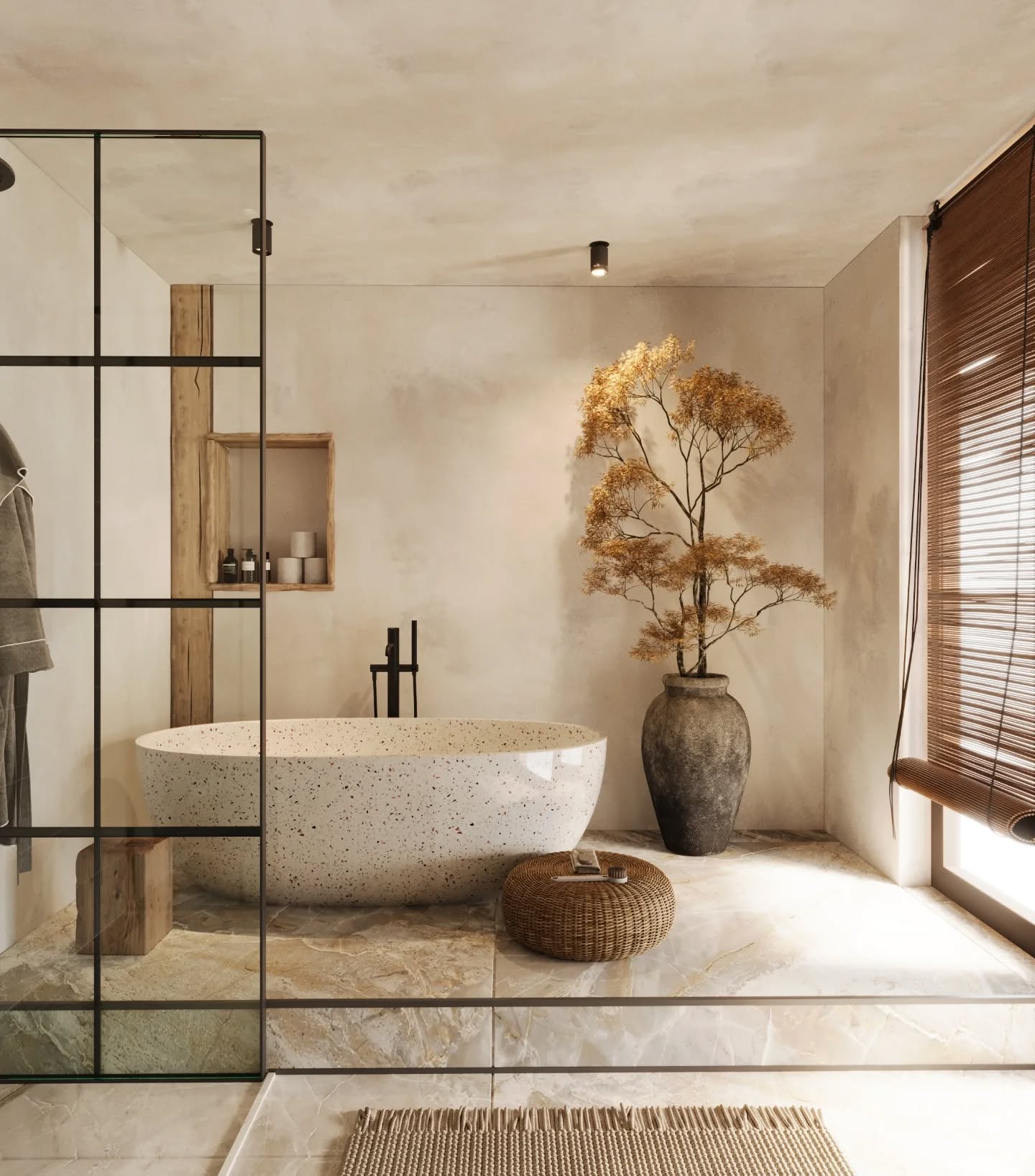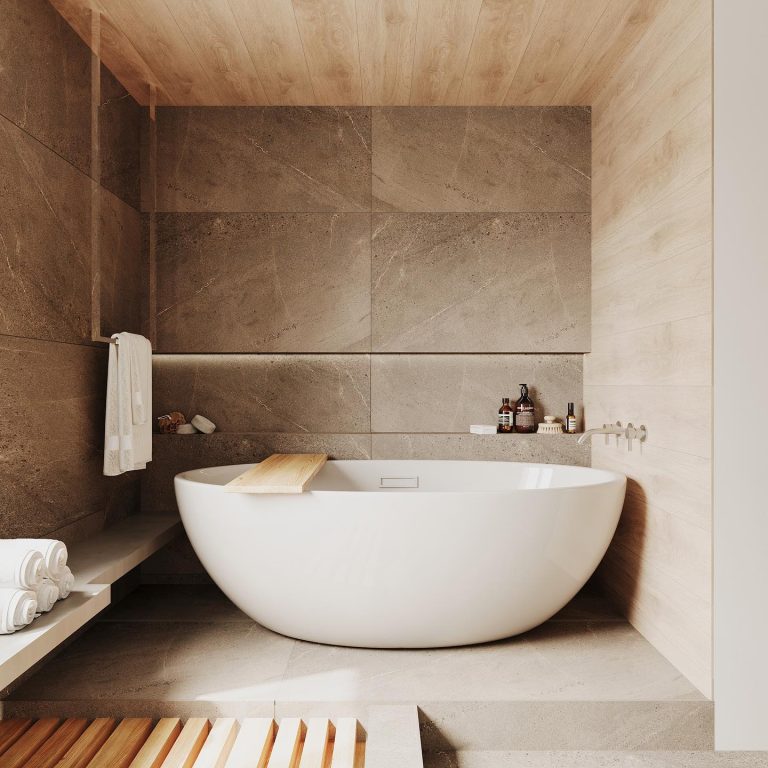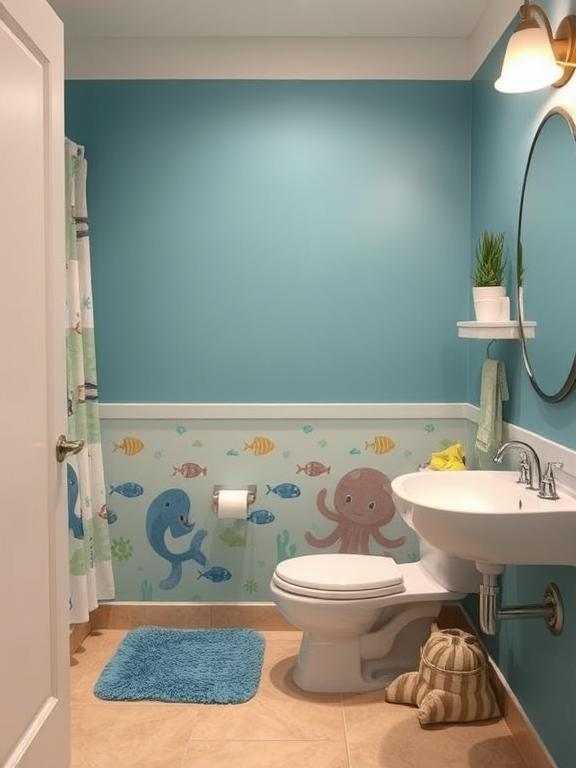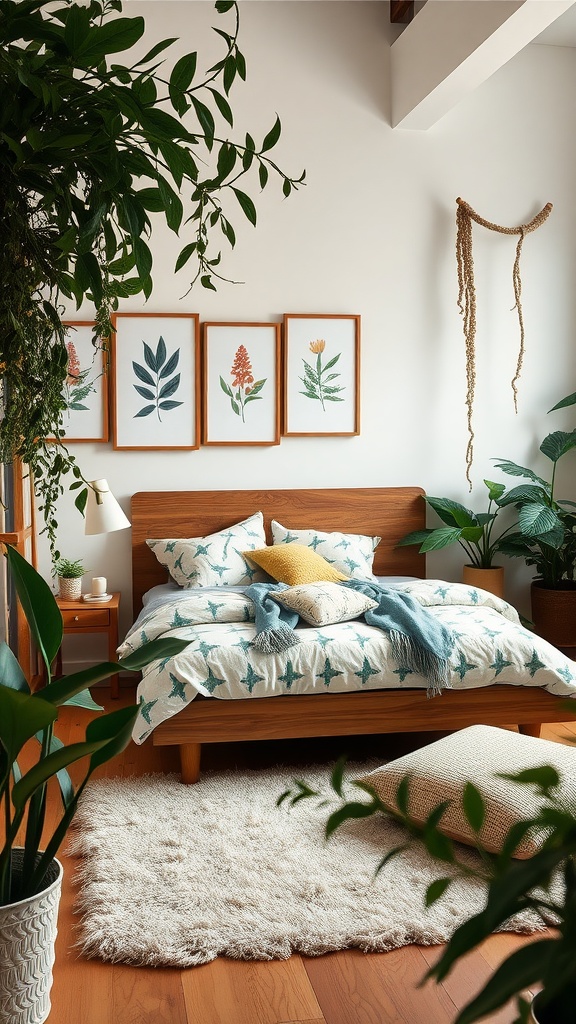25 Japandi Bathroom Ideas
Looking to bring calm, clarity, and quiet luxury into your bathroom? Say hello to Japandi style — the perfect blend of Japanese minimalism and Scandinavian coziness.
Japandi bathrooms are serene, functional, and refreshingly modern, making them ideal for anyone craving a clean space with warm, natural touches. Whether you’re doing a full remodel or simply updating your bathroom decor, this list of ideas will help you transform your bathroom into a relaxing retreat that embraces simplicity and style.
Let’s dive into 25 Japandi bathroom ideas that can elevate your everyday routine and bring peaceful vibes to your space.
1. Natural Wood Accents

One of the most recognizable features of Japandi design is the use of natural wood elements, especially in warm, mid-tone finishes like oak, teak, or ash. These tones create a cozy, grounded atmosphere that complements the minimalist aesthetic.
Consider incorporating wood through floating vanities, shelving, trim, or even a wooden bathtub tray. Light wood cabinets paired with clean white walls or soft gray tiles create an effortlessly elegant vibe. The organic look of real wood gives the bathroom a spa-like feel that never goes out of style.
If you’re concerned about moisture, look for sealed or water-resistant wood finishes or use wood-look porcelain tiles for a similar effect. Combining wood with stone or ceramic pieces adds to the balanced, natural harmony that makes Japandi bathrooms so calming.
2. Matte Black Fixtures
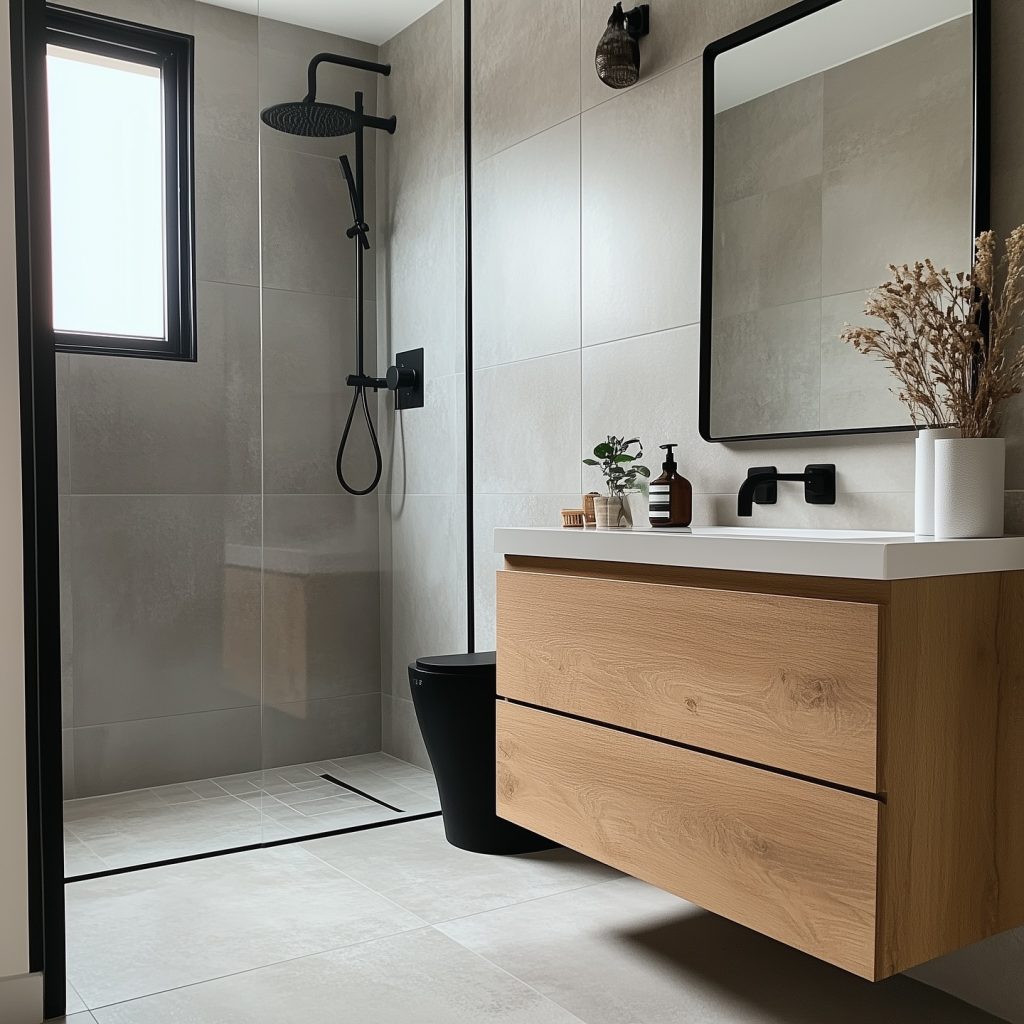
Matte black fixtures are a Japandi staple — sleek, understated, and beautifully modern.
Swap out shiny chrome or brushed nickel hardware in favor of matte black faucets, showerheads, towel bars, and handles. The contrast these pieces create against pale wood and neutral tiles is visually striking without being overpowering.
Black finishes also offer a subtle edge to the soft, neutral palette typical of Japandi bathrooms. They ground the space and provide a modern update that still honors minimalism. This small design choice can make your bathroom feel both trendy and timeless — a hallmark of Japandi style.
Plus, black fixtures pair effortlessly with other popular outdoor living and modern back porch ideas, making your indoor-outdoor decor feel cohesive and intentional.
3. Floating Vanities
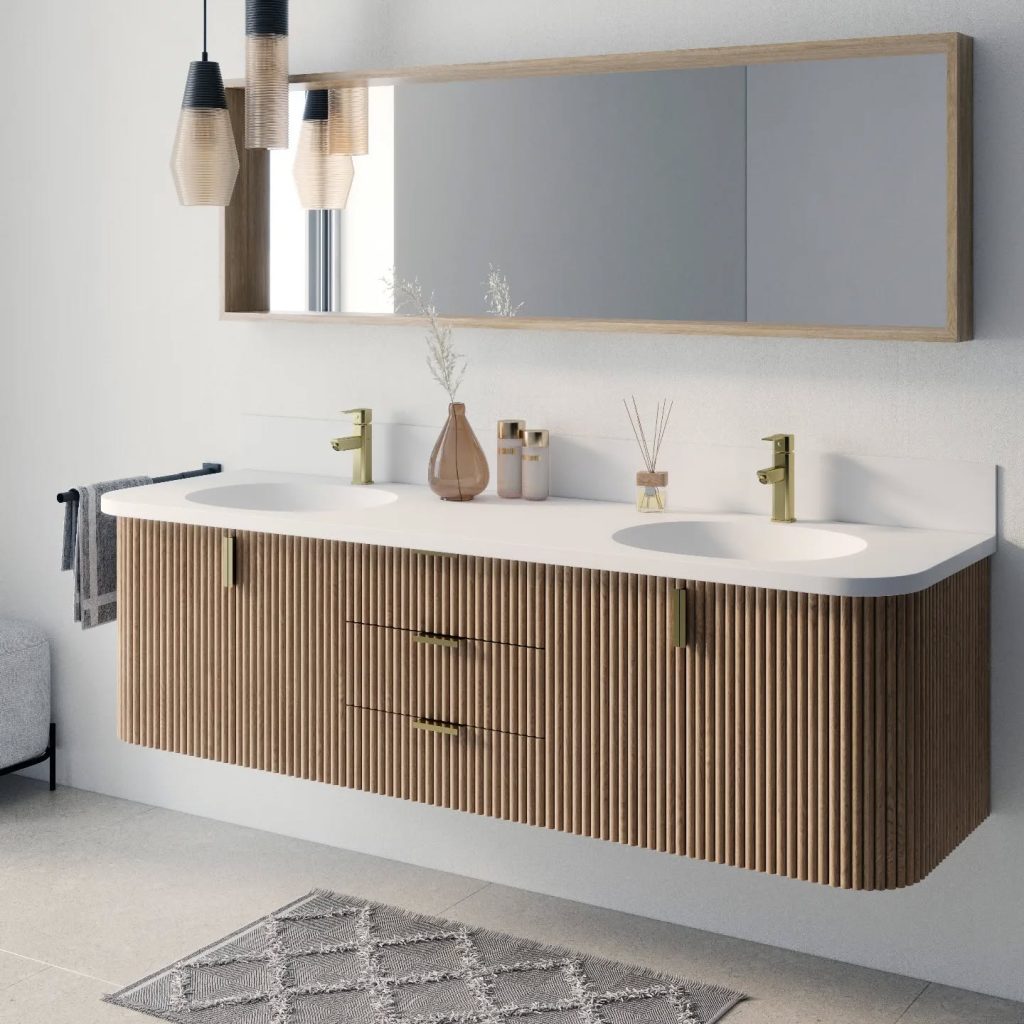
Floating vanities are a design-forward choice that blends functionality with the clean lines Japandi style is known for.
By lifting the vanity off the floor, you open up visual space and create a lighter, more open feel — perfect for smaller bathrooms or minimalist layouts. Choose vanities made of natural or light-stained wood with a simple rectangular sink to stay true to the Japandi aesthetic.
The open space below can also double as extra storage for baskets, rolled towels, or even a small indoor plant to keep the area feeling fresh and organic. Pair your floating vanity with soft LED underlighting for an added sense of calm and luxury.
This detail not only reflects modern patio furniture trends in indoor settings, but also gives your bathroom a design-forward upgrade.
4. Earth-Toned Color Palettes
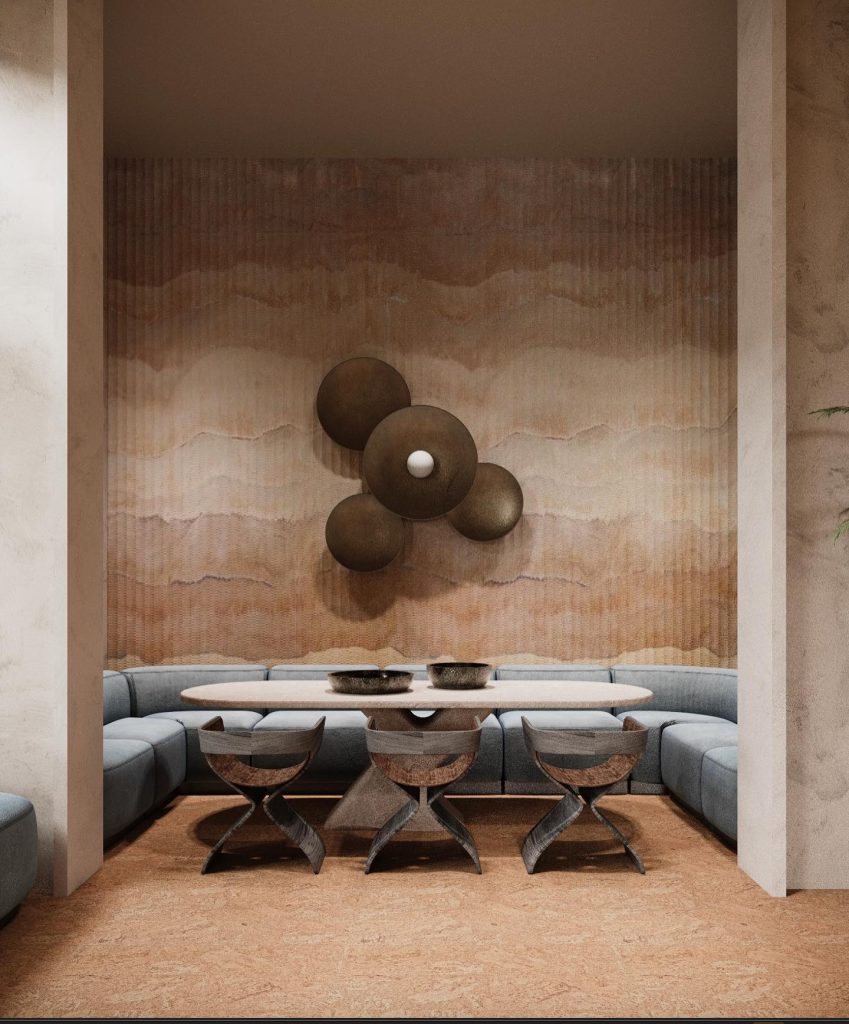
Color is key when it comes to Japandi design. Earthy, muted tones are the foundation — think warm taupes, soft whites, muted greens, and gentle grays.
These shades create a serene, grounded feel and serve as the perfect backdrop for wood textures and black accents. Use earth tones on walls, tiles, cabinetry, and textiles to give your space that signature Japandi tranquility.
Avoid anything too stark or bright — instead, lean into natural shades that mimic sand, clay, stone, or fog. These colors work together harmoniously and allow other design elements, like wood grain or ceramic textures, to shine.
This natural palette makes your bathroom feel like an extension of nature — tying in beautifully with outdoor living inspiration.
5. Wabi-Sabi-Inspired Decor
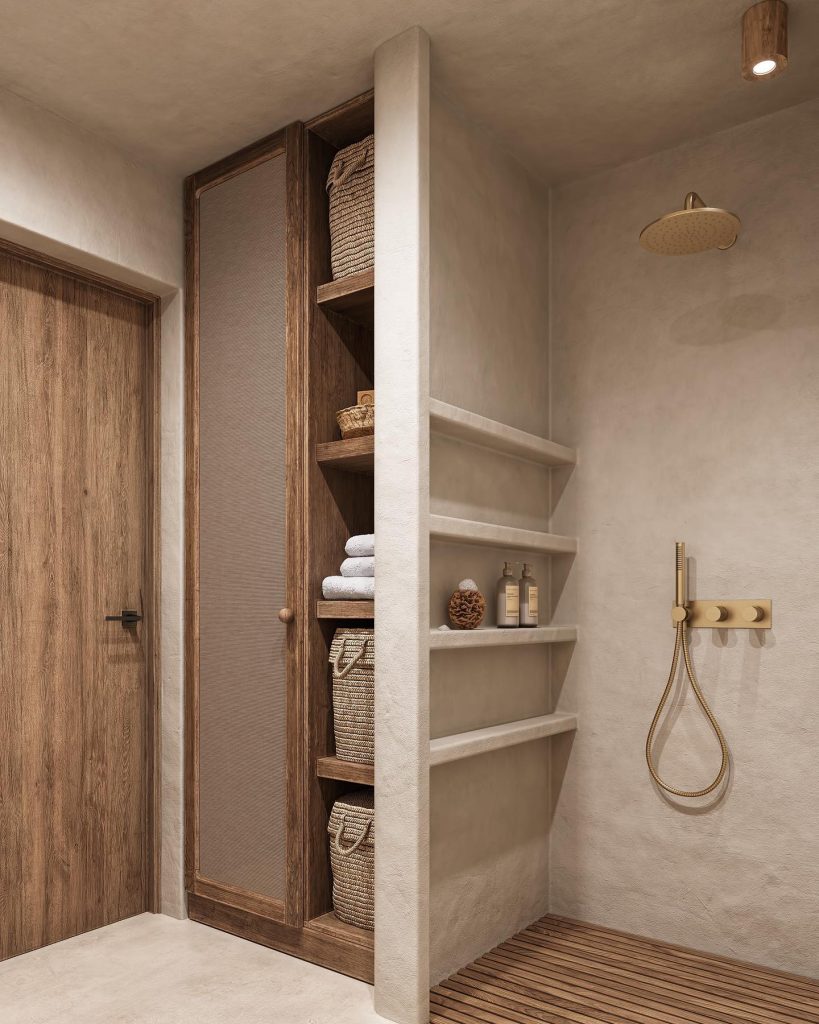
At the heart of Japanese aesthetics is wabi-sabi — the beauty of imperfection.
In a Japandi bathroom, this might look like handcrafted pottery, slightly irregular tiles, or a raw-edge wooden stool. Instead of trying to make everything match perfectly, embrace the character that comes with natural materials and handmade items.
A slightly uneven ceramic vase or linen shower curtain with a crinkled texture can add charm and personality while staying true to the clean Japandi look. The result is a space that feels lived-in, meaningful, and deeply calming.
This concept fits right in with modern back porch decor trends too — where handcrafted, rustic items bring comfort and authenticity to a space.
6. Large Format Neutral Tiles

Japandi style favors simplicity in scale and repetition, which makes large-format tiles an ideal choice for walls or floors.
Go for matte tiles in neutral shades — beige, warm gray, off-white — that mimic natural stone or raw clay. Their larger size minimizes grout lines, creating a smoother, more seamless appearance. This helps create the uncluttered, calming aesthetic Japandi is known for.
For floors, large tiles are also practical and easy to clean — perfect for busy mornings or evening self-care rituals. Consider using the same tile across walls and floors for a cohesive, streamlined look.
Paired with wooden accents and soft lighting, large tiles bring a feeling of quiet luxury — like stepping into a boutique spa retreat.
7. Bamboo Accessories
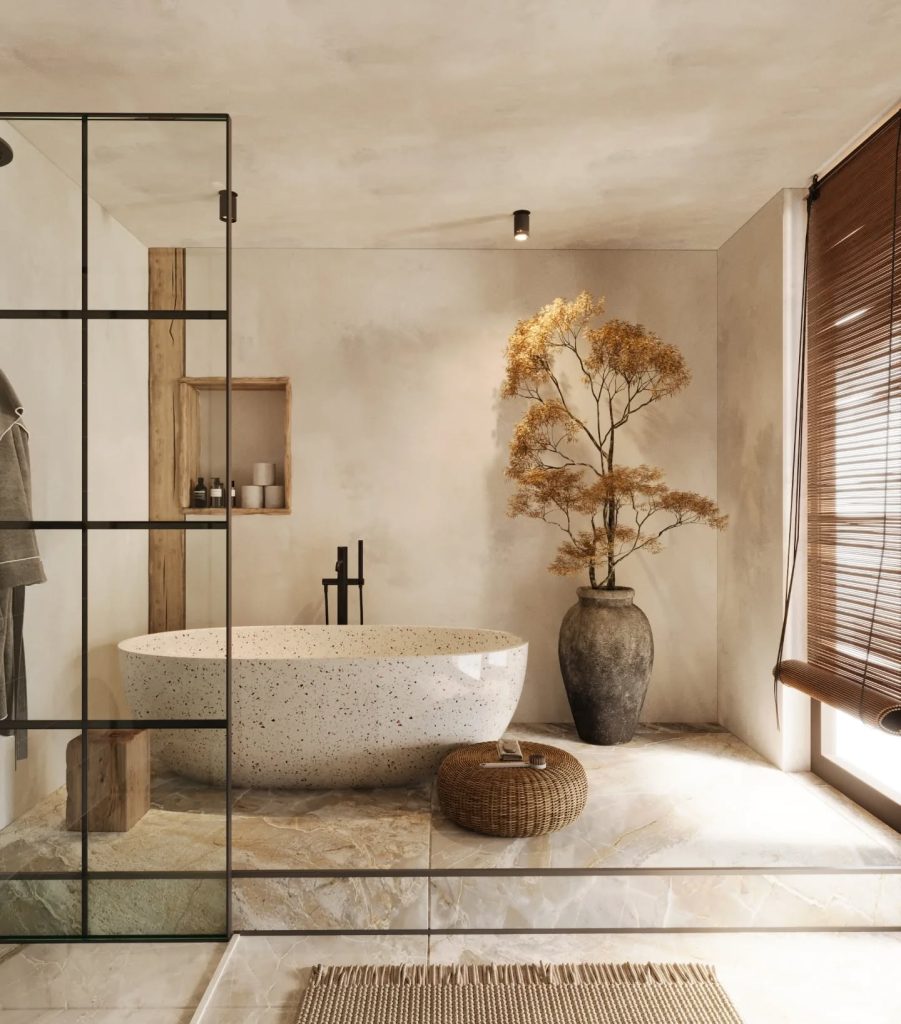
Bamboo is a sustainable, natural material that brings warmth and a Zen-like energy to your bathroom.
Think bamboo bath mats, trays, toothbrush holders, or shelving units. Its light color and subtle texture work perfectly with Japandi’s calm, minimalist color scheme. Bamboo also plays well with both Japanese and Scandinavian influences, which is what makes it such a natural fit.
This material is also very eco-conscious — a major plus for modern design lovers who care about sustainability. It’s easy to maintain, lightweight, and adds a soft organic texture that enhances the spa-like ambiance.
Adding bamboo accessories is an easy, budget-friendly way to bring Japandi style into your space without committing to a full renovation.
8. Minimalist Freestanding Tubs
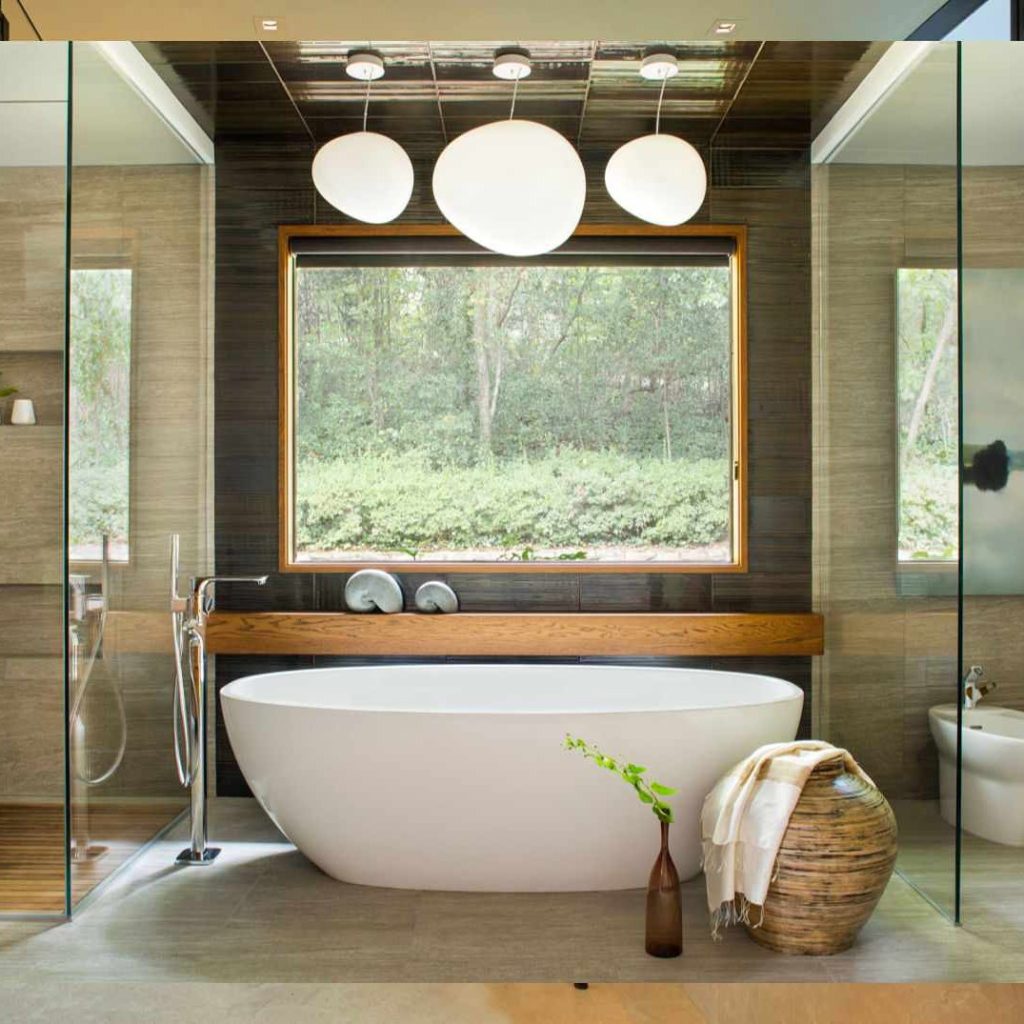
Freestanding bathtubs are the epitome of Japandi luxury. Their sculptural form creates a beautiful focal point, while also encouraging slow, restorative rituals.
Choose a tub with soft curves and a matte finish in white or stone-gray. Place it near a large window if possible, or tuck it into a cozy corner with a small wooden bench or bath caddy nearby.
Keep surrounding decor minimal — just a bamboo bath mat, a candle, and a folded towel. This restrained elegance enhances the Japandi philosophy of simplicity and serenity.
Not only do these tubs add a spa-like feel to your bathroom, but they also channel the same relaxed luxury seen in modern patio furniture and outdoor soaking tubs.
9. Rice Paper or Linen Window Treatments
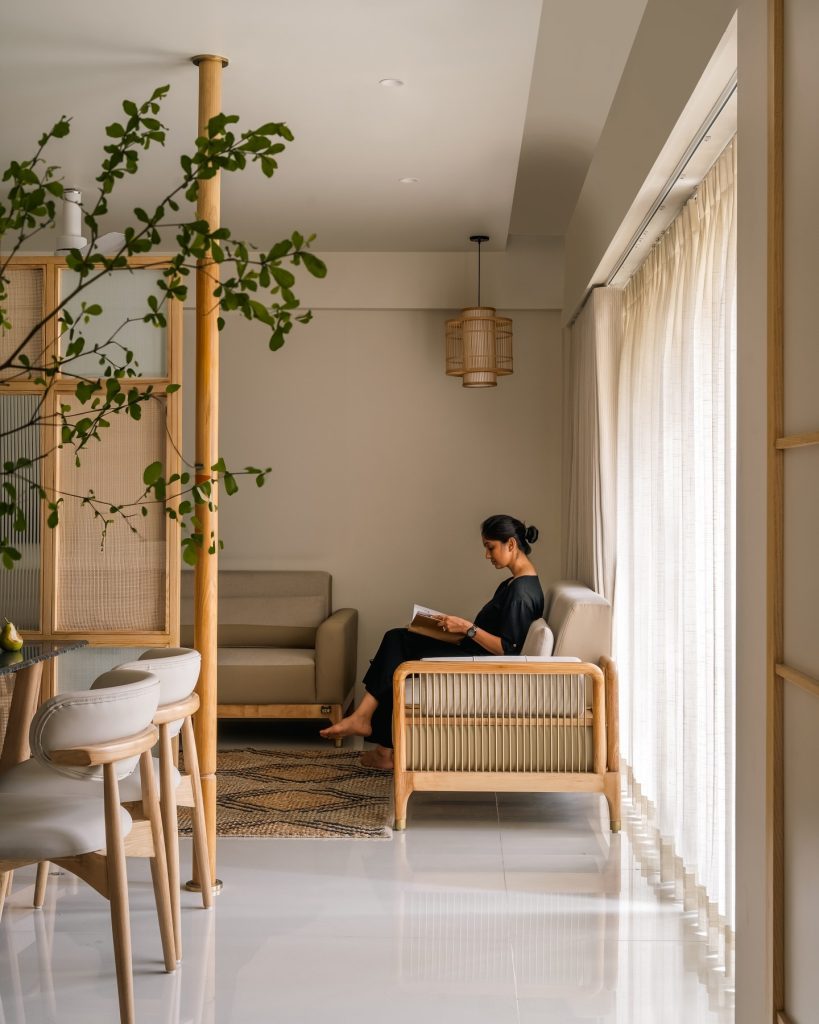
When it comes to Japandi-style window coverings, soft, natural fabrics are the way to go.
Linen or rice paper blinds filter light beautifully while maintaining privacy and a sense of calm. Stick to neutral shades — ivory, beige, or soft gray — to keep the palette consistent and soothing.
Avoid heavy or overly patterned curtains. Instead, opt for sheer or semi-sheer materials that bring a light and airy feeling to your space. The soft diffusion of sunlight through these fabrics adds a tranquil, peaceful glow.
This small touch can dramatically change the feel of your bathroom, echoing the same airy openness that people love in their modern outdoor living spaces.
10. Soft, Diffused Lighting
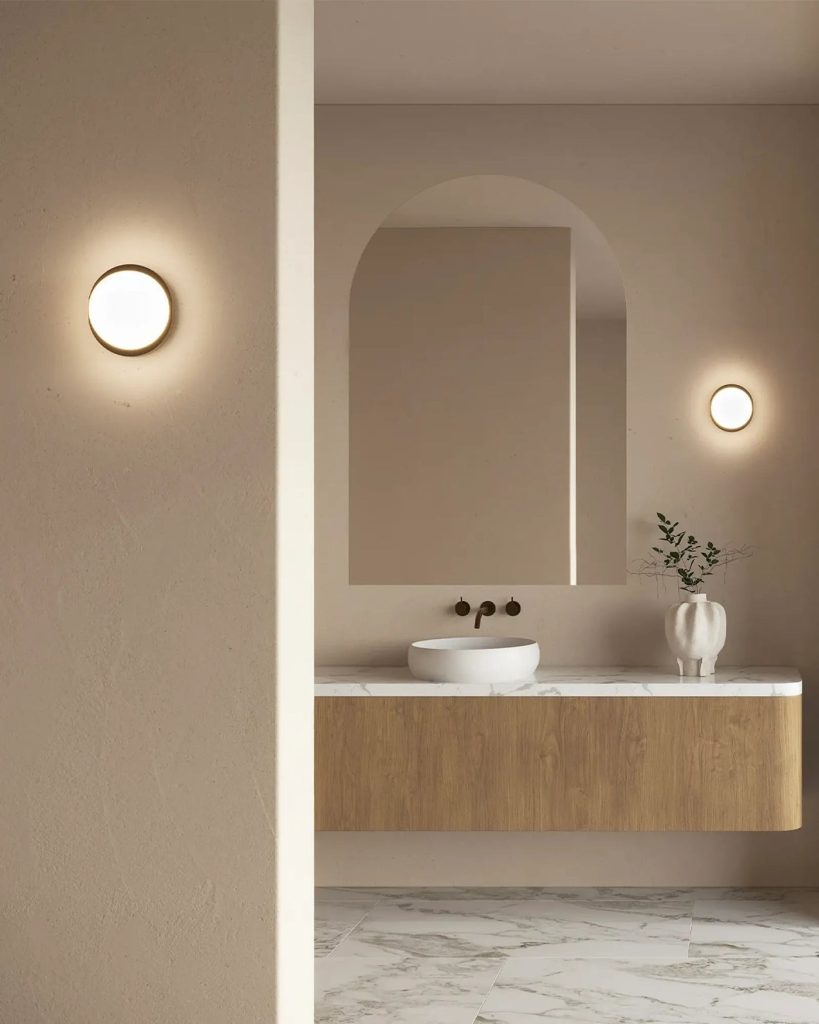
Lighting in a Japandi bathroom should be soft, warm, and subtle. Harsh overhead lights don’t belong here.
Instead, opt for pendant lights with linen or frosted glass shades, warm white LEDs behind mirrors, or sconces mounted beside vanities. The goal is to create gentle, layered lighting that mimics natural daylight.
Avoid blue-toned bulbs or spotlight-style fixtures. Instead, think spa lighting — calm, ambient, and flattering. A well-lit bathroom should feel like a sanctuary, not a surgery room.
Bonus: adding dimmers to your bathroom lights lets you shift the mood based on the time of day — from early morning prep to late-night relaxation.
11. Pebble or River Stone Shower Floors
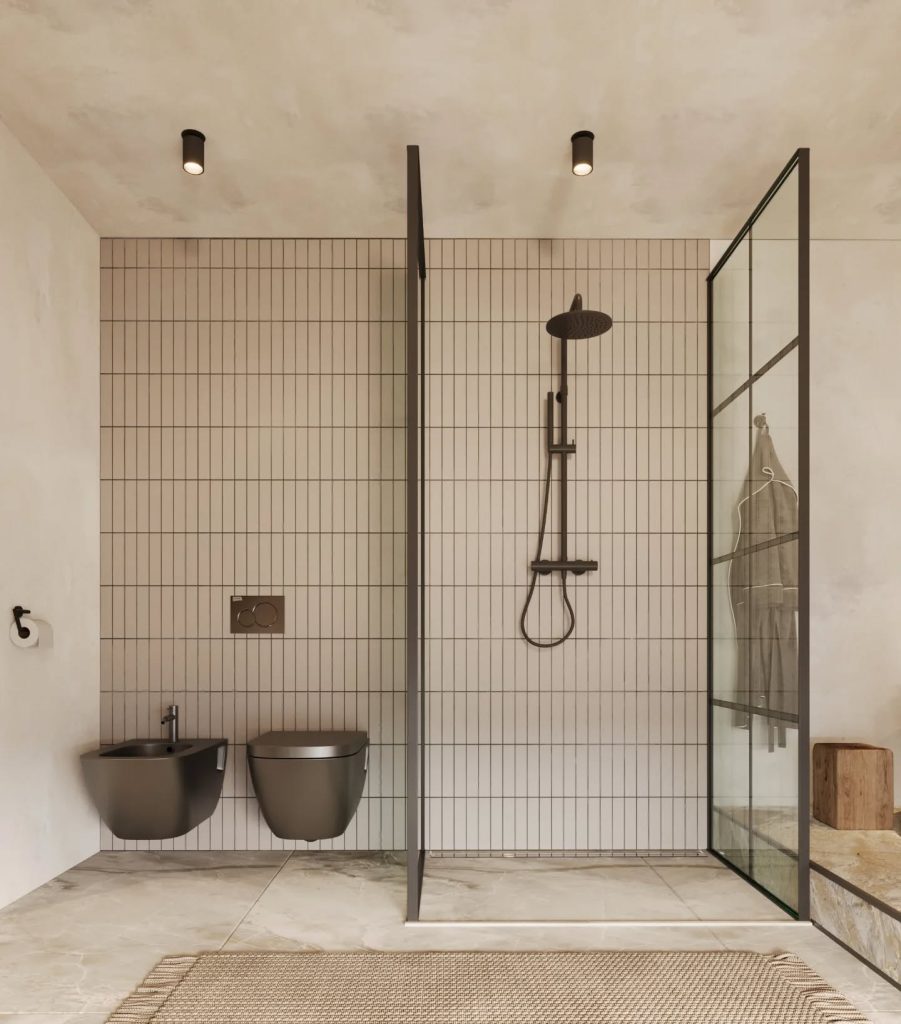
A tactile, nature-inspired shower floor is a beautiful way to bring Japandi influence into your bathroom.
Pebble or river stone tiles add texture and an organic feel underfoot. Choose smooth, neutral-toned stones that evoke a Zen garden path — soft grays, tans, and creamy whites work best.
Pair them with large-format tiles on the walls and a frameless glass shower enclosure for a minimalist, spa-like atmosphere. The slight irregularity of the stones offers both aesthetic appeal and gentle foot massage, turning your shower into a daily wellness ritual.
These natural textures also echo materials often seen in modern back porch ideas, especially in outdoor showers and garden walkways.
12. Simple Framed Mirrors

In Japandi design, even the mirror makes a quiet statement.
Opt for a round or rectangular mirror with a slim, minimalist frame — usually in wood, black metal, or brass. Keep it free from ornate details or bright lights. The goal is simplicity and softness, both in form and function.
Consider backlit LED mirrors to add gentle, diffused light to your morning routine. A frameless or beveled-edge mirror can also work, as long as the design stays clean and unobtrusive.
Mirrors reflect light and expand space — ideal for smaller bathrooms — and when chosen thoughtfully, they enhance the room’s peaceful, well-balanced feel.
13. Open Shelving with Rolled Towels
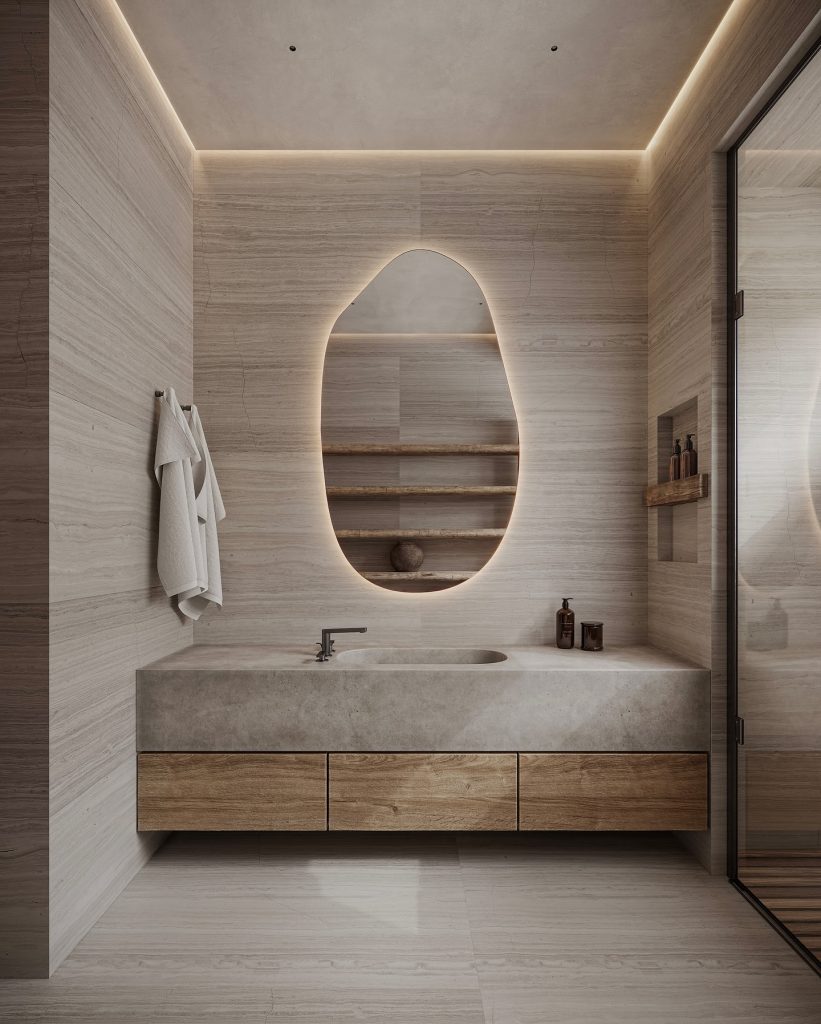
Instead of closed cabinetry, Japandi bathrooms often incorporate open wood shelving with beautifully folded or rolled towels.
This approach keeps things functional yet stylish. Use shelves to display neatly stacked towels, a few glass jars with bathroom essentials, and maybe a ceramic dish or two.
Keep clutter out of sight and focus on minimal, intentional styling. The key is having everything you need within reach — but nothing extra.
This minimalist organization style mirrors outdoor living trends too, where form and function work hand-in-hand to create visually peaceful spaces.
14. Ceramic Vessel Sinks
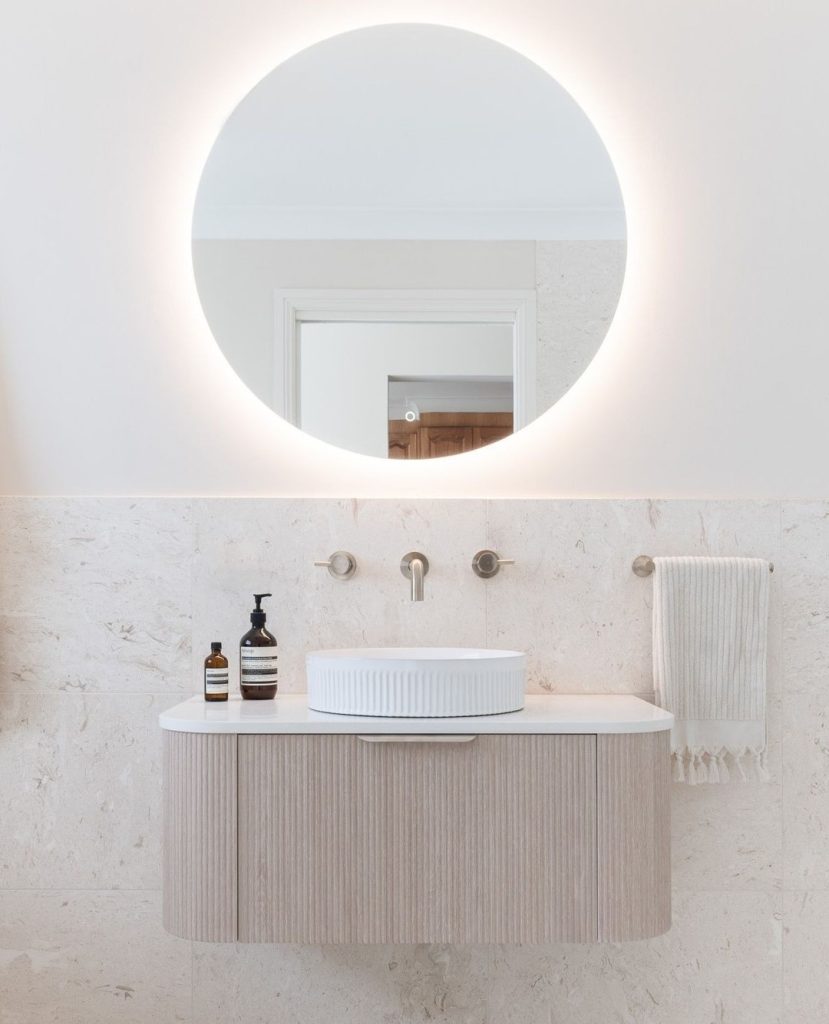
One of the most eye-catching features you can include in a Japandi bathroom is a ceramic vessel sink. These elevated sinks often have a handcrafted feel, adding an organic, artisanal element to your space.
Look for sinks with matte finishes in soft neutrals like stone-gray, off-white, or pale taupe. Rounded or asymmetrical shapes echo the wabi-sabi design principle — celebrating the imperfect, the natural, and the handmade.
When paired with a wooden or stone countertop and a minimalist faucet (especially in black or brass), vessel sinks bring a spa-like feel that is both sculptural and serene.
Not only are these sinks functional, but they also act as a beautiful focal point — blending utility with quiet sophistication in true Japandi style.
15. Concrete or Stone Countertops
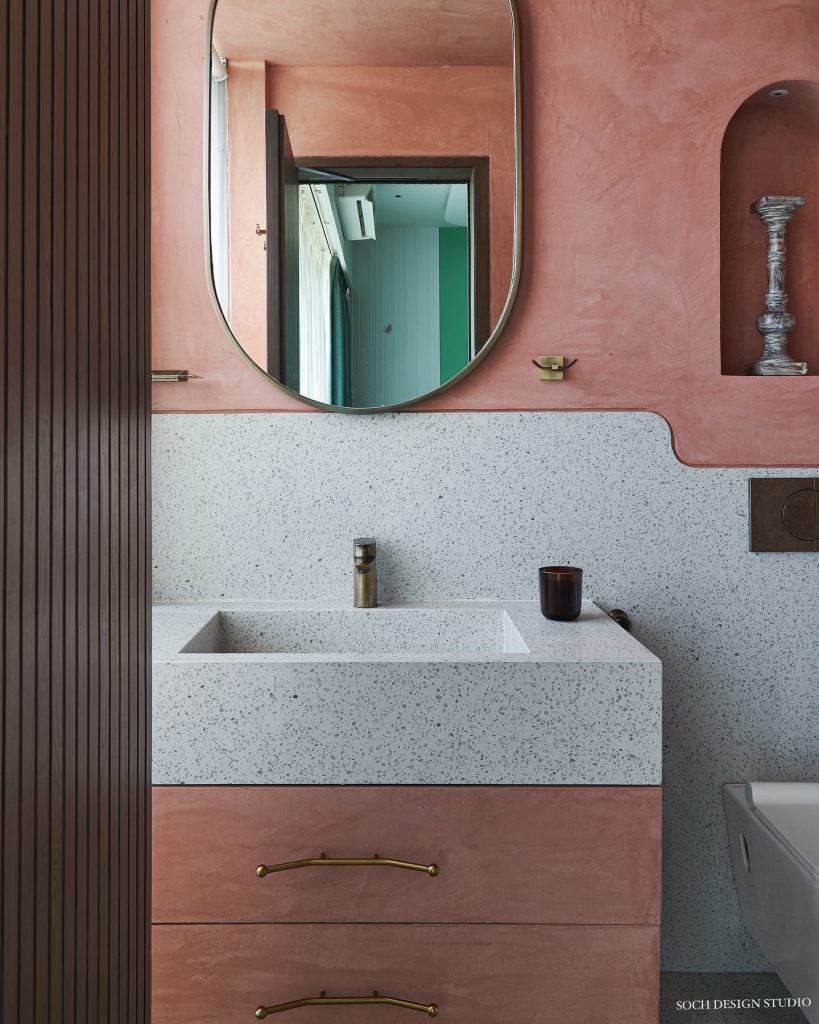
Japandi design leans heavily on raw, natural materials — and stone or concrete countertops are a perfect fit.
Concrete adds an industrial edge while still feeling grounded and minimalist. Meanwhile, stone options like soapstone, travertine, or honed marble offer a more organic look, depending on your color palette and texture preferences.
These materials are durable, low-maintenance, and visually striking without being flashy. Their cool-toned, matte surfaces pair beautifully with natural wood cabinetry and soft lighting.
Stone and concrete also work well with outdoor living inspiration — often seen in modern patio furniture and garden accents — so your indoor spaces feel like a natural extension of the outdoors.
16. Indoor Plants for a Zen Touch
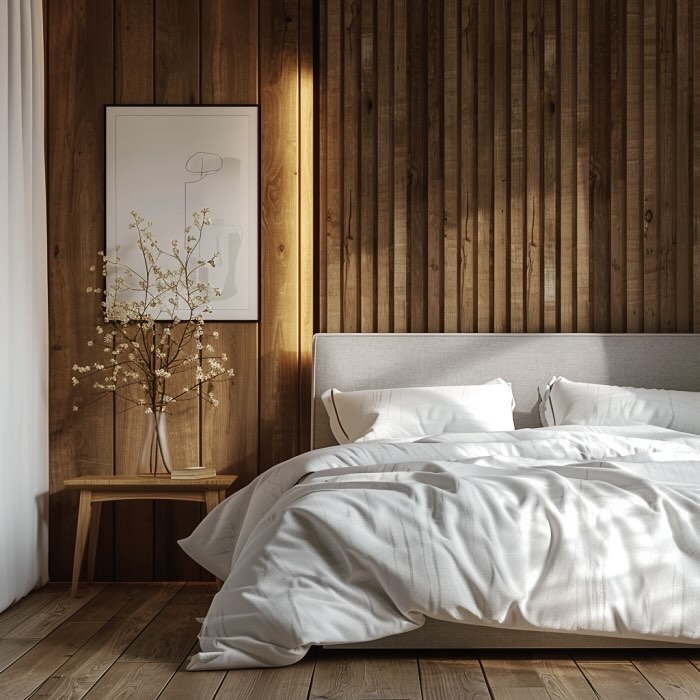
Bringing indoor plants into your Japandi bathroom is one of the easiest ways to enhance the peaceful, earthy vibe.
Choose low-maintenance plants like snake plants, pothos, peace lilies, or ferns — all of which thrive in humid environments. Place them on open shelving, next to the tub, or even hanging from the ceiling in minimalist planters.
Greenery adds softness and life to the neutral Japandi palette while improving air quality and boosting your mood. Even one or two carefully placed plants can make a big impact.
This idea also pulls from the outdoor living trend of blurring the lines between indoor and outdoor spaces, bringing a little slice of nature into your daily self-care routine.
17. Sliding Wooden Doors (Shoji or Barn-Style)
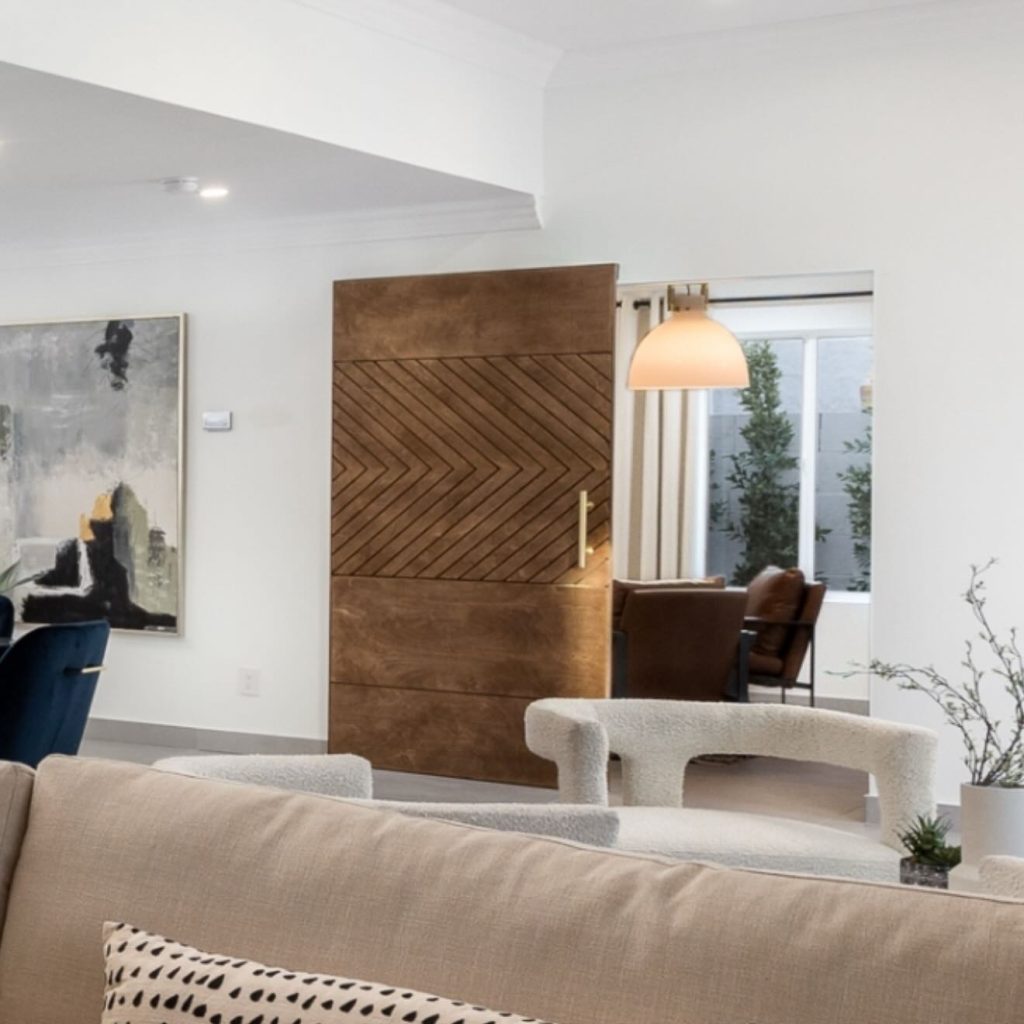
For an authentic and functional touch, consider installing a sliding wooden door in your Japandi bathroom.
Shoji doors — traditional Japanese sliding panels with wood frames and rice paper — offer a translucent elegance that softly filters light while maintaining privacy. If you prefer a Scandinavian twist, opt for minimalist barn-style sliding doors in natural wood tones.
Both styles are space-saving and add visual interest without overwhelming the design. They also enhance the flow of your bathroom, creating a seamless, open feeling throughout your home.
It’s a practical yet stylish way to add character while staying true to Japandi’s balance between beauty and utility.
18. Textured Wall Panels (Wood or Stone-Look)

Texture plays a quiet but powerful role in Japandi interiors, and wall panels made from wood or stone-look materials are a great way to add dimension.
Wood slats or vertical paneling bring warmth and depth, especially when used behind a vanity or bathtub wall. On the other hand, faux-stone or clay-look panels add a tactile quality that complements the clean lines and neutral palette.
Keep the colors subtle — soft browns, grays, or whites — and allow the texture to do the talking. These panels enhance the calming vibe of the space while offering an easy, high-impact visual upgrade.
This kind of design is also on trend with modern back porch ideas, where natural materials define the tone and mood of a relaxing environment.
19. Wall-Hung Toilets
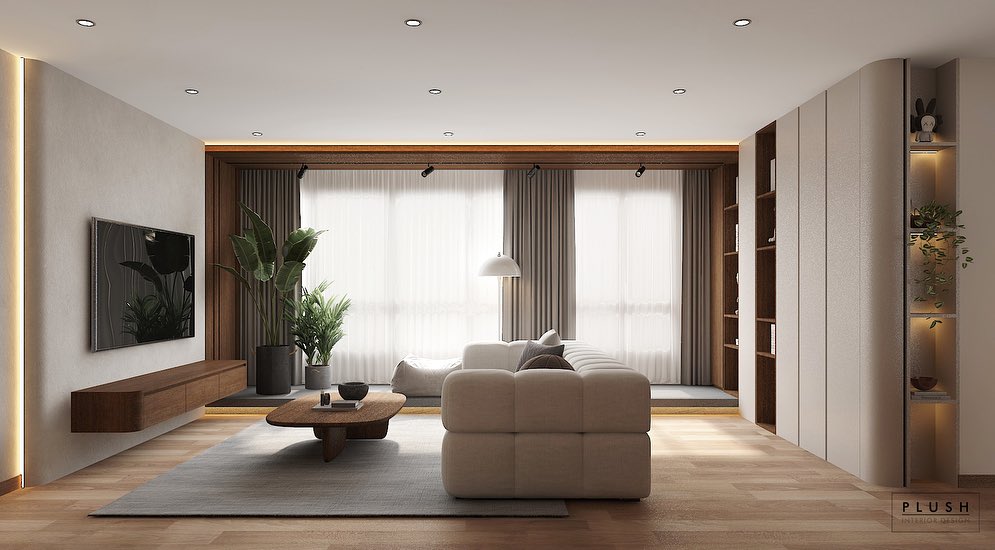
Wall-hung toilets are a sleek and modern option that align beautifully with Japandi’s minimalist values.
Mounted directly to the wall, these toilets free up floor space, making your bathroom feel more open and easier to clean. The concealed tank and clean lines keep the focus on simplicity and function — without sacrificing style.
Pair your wall-hung toilet with soft, earthy tilework and a floating vanity for a cohesive look. While it may be a more involved installation, it’s a high-end touch that pays off in both aesthetics and practicality.
Perfect for a spa-inspired environment where every detail counts.
20. Japandi-Inspired Art Prints
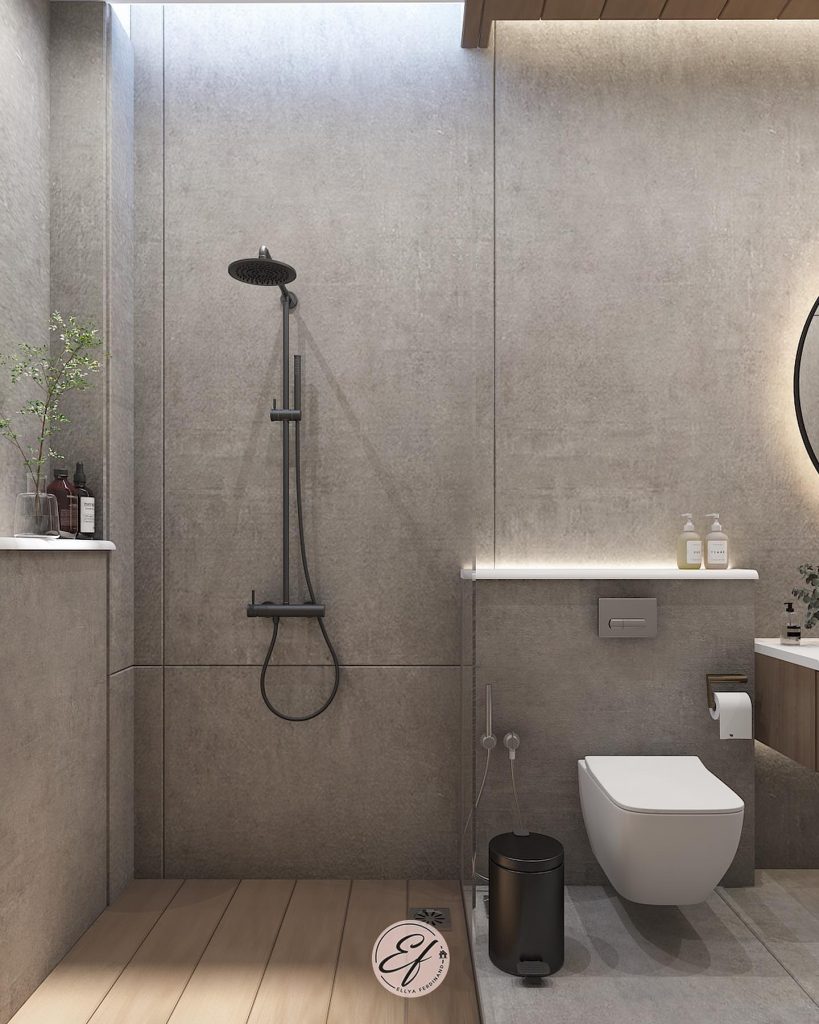
Wall art in a Japandi bathroom should be subtle and serene — think line drawings, minimalist landscapes, or brushstroke-style prints in soft neutral tones.
Choose pieces that evoke calm, nature, or abstract minimalism. Stick with one or two framed artworks to avoid visual clutter. Wood frames in light finishes or black metal are ideal for staying on-theme.
Art adds warmth and personal character to a bathroom while supporting the Japandi philosophy of mindful decor.
Like outdoor spaces filled with curated textures and meaningful touches, Japandi bathrooms should feel intentional and balanced — art is the finishing layer that brings it all together.
21. Cotton or Linen Towels in Soft Neutrals

No Japandi bathroom is complete without plush, natural-fiber towels in muted colors.
Choose organic cotton or linen in shades like warm white, stone gray, or soft beige. These colors blend seamlessly with the rest of your decor while adding a cozy, tactile layer.
Rolled or neatly folded on open shelves or wooden ladders, these towels double as both functional and aesthetic elements.
Steer clear of bold colors or patterns — Japandi is all about calming, cohesive textures. These towels don’t just look great; they elevate your daily routine and turn everyday essentials into moments of simple luxury.
22. Built-In Niches for Storage
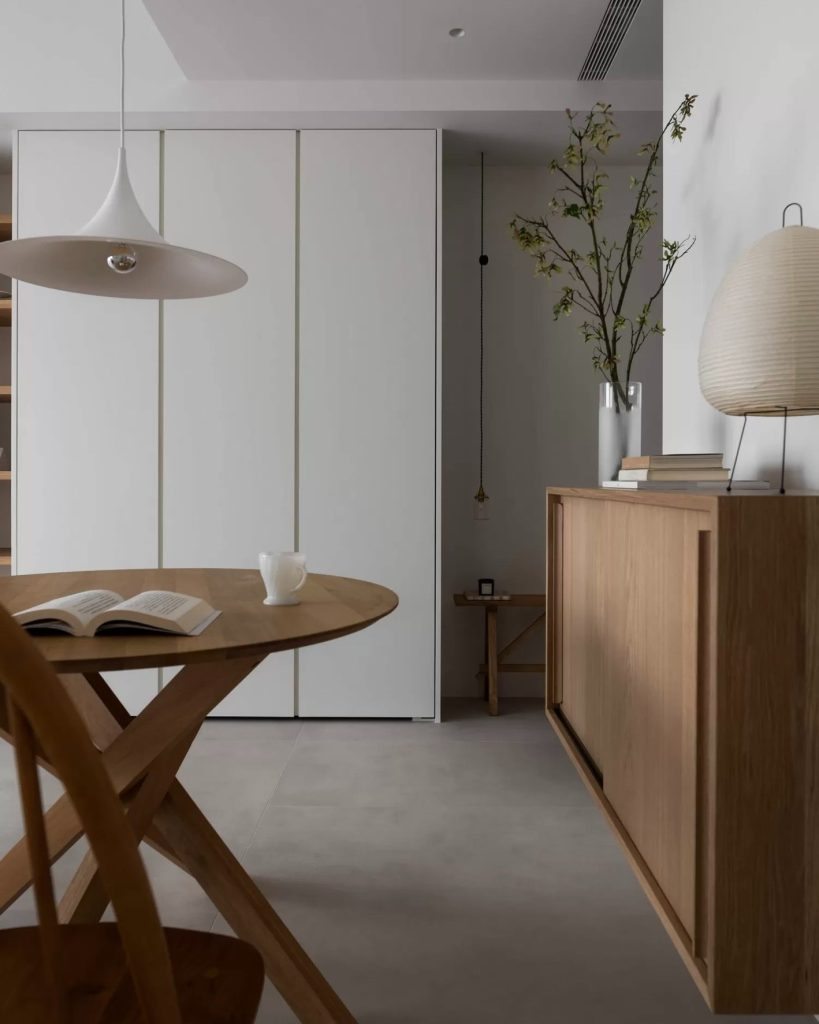
Built-in niches offer practical storage while maintaining the sleek look that Japandi style demands.
Perfect for showers or above bathtubs, niches provide a place for shampoo bottles, soaps, candles, or decorative objects — all without the bulk of added furniture. Use the same tile or a contrasting natural texture to line the niche and create subtle depth.
These features help eliminate clutter, keeping your space clean and intentional. You’ll never need to worry about clunky baskets or over-the-door racks again.
It’s the kind of thoughtful design that works equally well in modern patio furniture layouts and bathroom interiors — where space, storage, and aesthetics work in harmony.
23. Minimalist Candle or Diffuser Setup
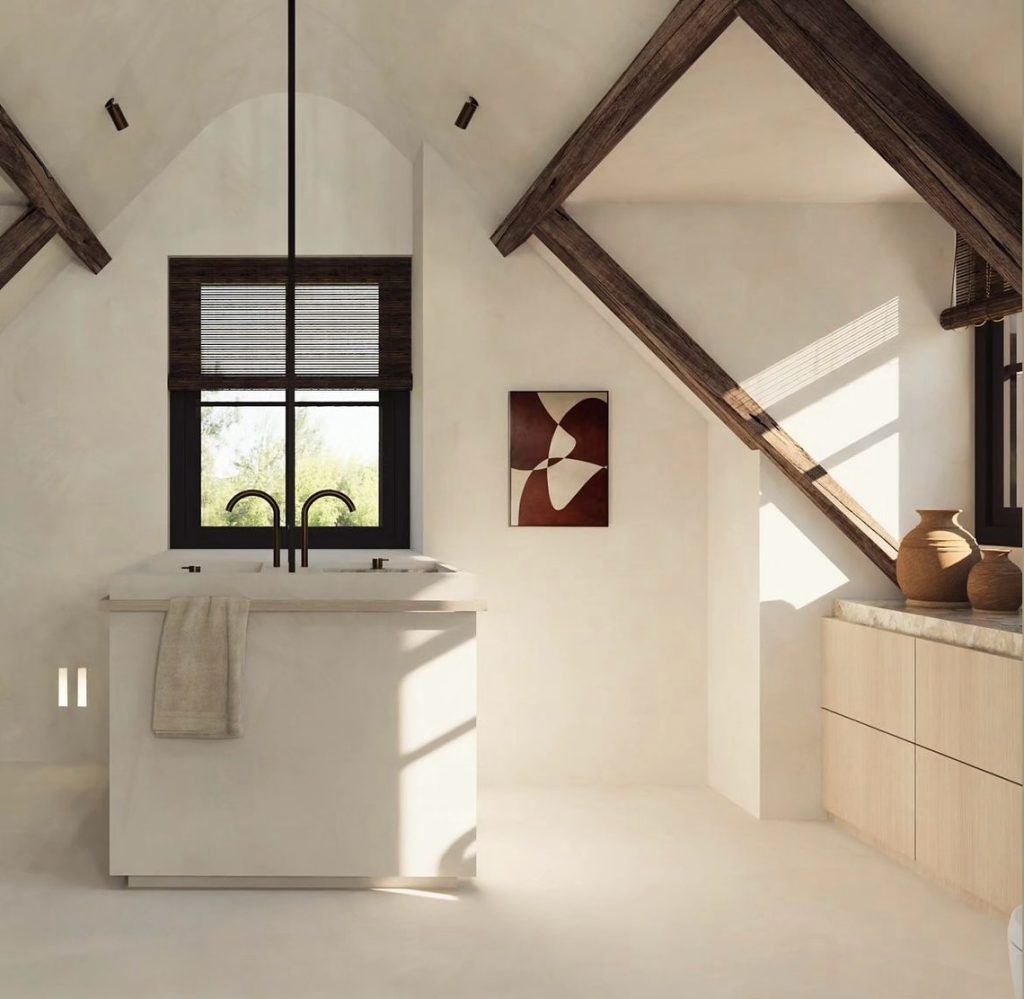
Scents are a key part of a calming space, and minimalist candles or diffusers are a Japandi must.
Look for soy or beeswax candles in simple ceramic holders or opt for an essential oil diffuser with a wood or stone finish. Scents like cedarwood, sandalwood, lavender, or eucalyptus align with the natural, soothing atmosphere you’re aiming for.
Keep the setup simple — one or two candles on a tray or shelf is enough. Not only do they elevate the spa experience, but they also contribute to the overall sense of peace and comfort in the space.
These small sensory details echo the coziness found in outdoor living spaces and hygge-inspired designs.
24. Layered Natural Materials (Wood, Stone, Rattan)
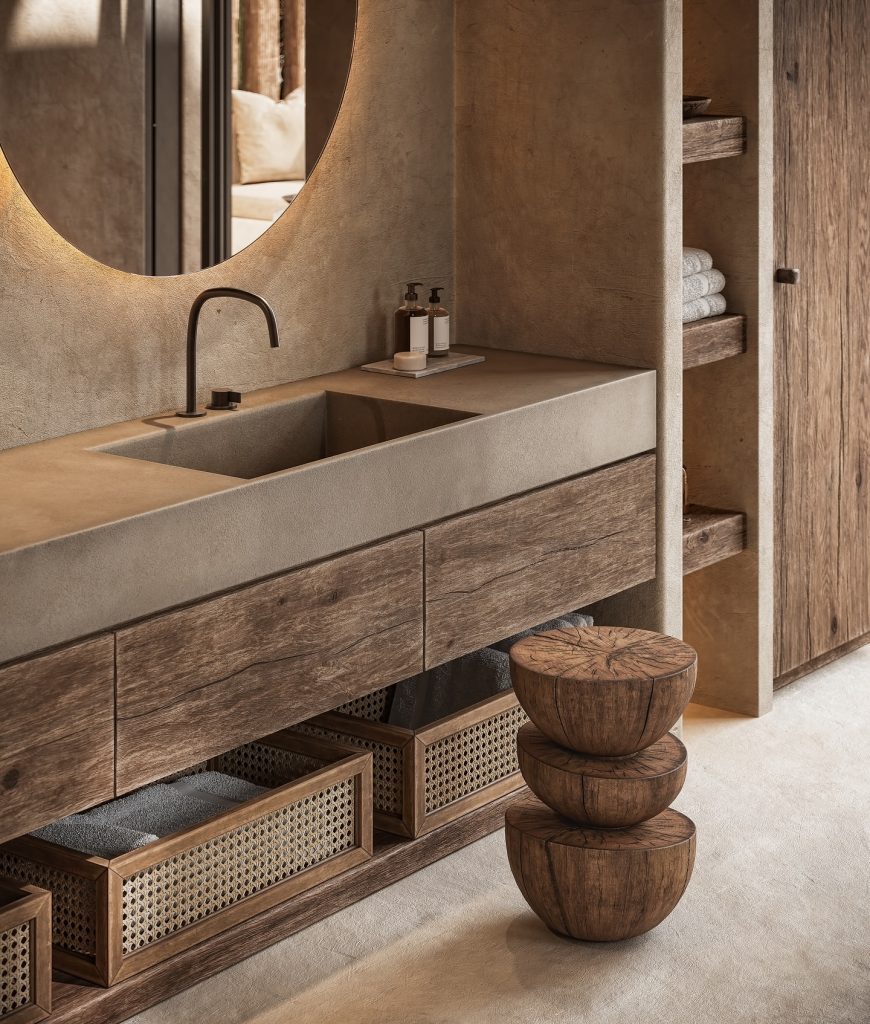
A hallmark of Japandi design is its beautiful balance of natural materials, layered in subtle ways to create interest without chaos.
Combine light wood with natural stone, woven baskets, linen towels, and perhaps a touch of raw metal or ceramic. Rattan baskets or stools add texture without overwhelming the design.
Each material brings a different temperature and tactile feel, creating a full sensory experience. The key is restraint — use just enough to feel warm and lived-in, but never cluttered.
This layering technique is often seen in both modern indoor decor and outdoor living setups where comfort, style, and nature intersect.
25. Balanced Layout with Negative Space
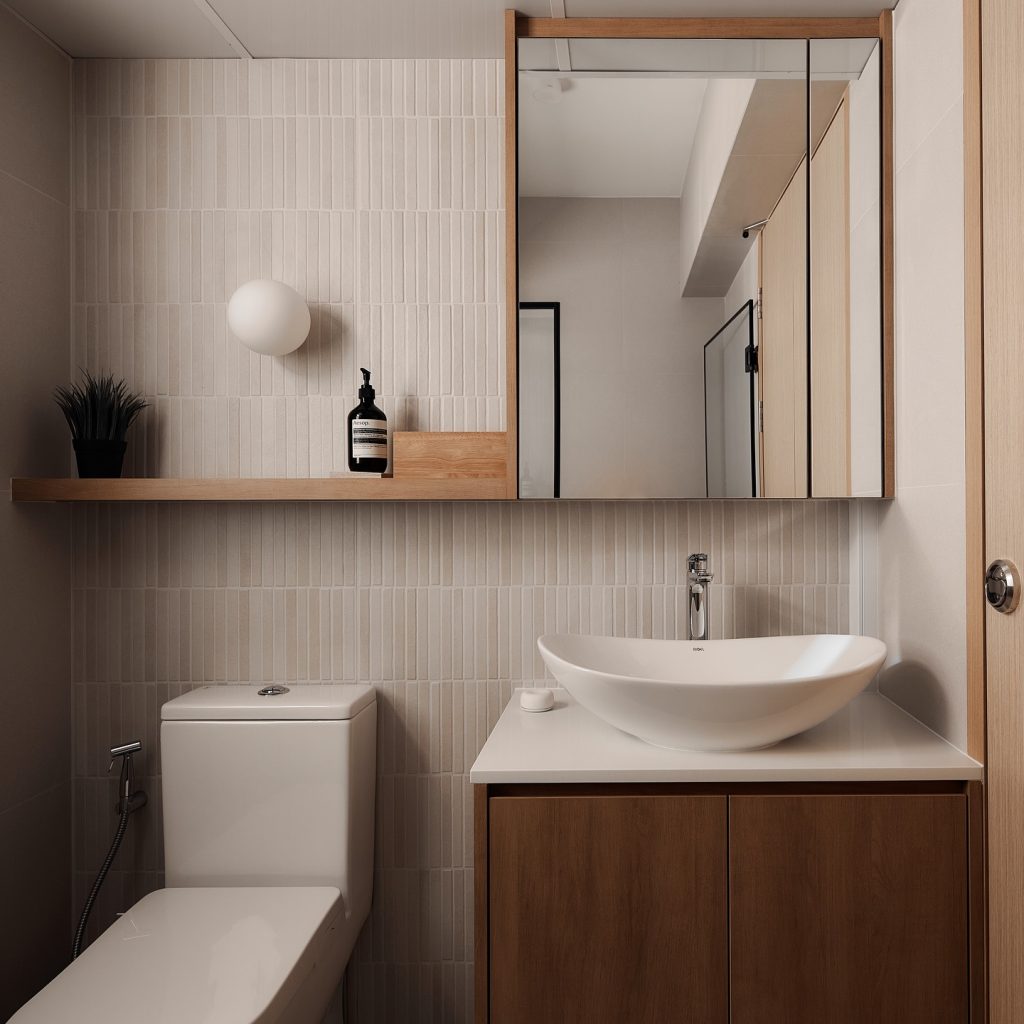
Finally, layout matters just as much as style when it comes to Japandi bathrooms. A truly tranquil space needs breathing room.
Rather than filling every inch with decor or storage, embrace negative space — the empty areas that give your eyes a place to rest. Keep walkways clear, furniture minimal, and decor pared down to the essentials.
Every piece in a Japandi space should have a purpose — whether functional or beautiful. A thoughtful layout that prioritizes flow and openness ensures the bathroom feels peaceful rather than crowded.
This philosophy mirrors the best of modern back porch decor, where a clean, simple setup fosters true relaxation.
Conclusion
Creating a Japandi bathroom isn’t just about choosing the right tiles or fixtures — it’s about crafting a calm, balanced space that supports your well-being.
By blending clean lines with natural textures, soft colors, and intentional details, you can transform your bathroom into a tranquil retreat that’s both functional and beautiful.
Whether you start with a bamboo bath tray or dive into a full renovation with a floating vanity and large-format tiles, every small step brings you closer to a space that feels like home.
Let your bathroom reflect the peace you want in your life — because serenity starts with your surroundings.

